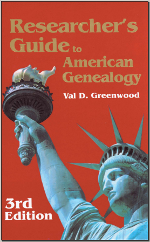Book Club Notes: Greenwood’s Evidence Types

Researcher’s Guide to American Genealogy
Recently the Genealogists on Second Life community started a book club, choosing to study Val D. Greenwood’s The Researcher’s Guide to American Genealogy (3rd Edition) a chapter at a time. For the first two meetings, we went discussed two chapters at a time, monthly, but we’ve currently shifted to one chapter per week.
One early chapter that prompted extra discussion of semantics was Chapter 4, “Evaluation of Evidence.” The evidence types and definitions seem based on the legal standards, and many seemed obvious, some some included a few head scratching moments. It’s a different set than that used in the Board for Certification of Genealogists’s “Evidence Evaluation Standards” (from The BCG Genealogical Standards Manual). The types of evidence and their basic definitions from Greenwood’s book begin with:
A. Direct Evidence […] evidence (or information) which, standing alone, tends to show the existence of a fact. It is evidence that relates directly to a precise issue. (Greenwood, 67)
B. Cicrumstantial Evidence […] (or indirect evidence) […] is evidence or information about facts and/or circumstances from which the existence (or non-existence) of a fact at issue may be inferred. (Greenwood, 67)
These two seem obvious enough. A few examples:
- A marriage certificate, for example, states the names of the bride and groom, date, and location of a marriage, and is therefore direct evidence that that marriage was performed by the signing officiator of the certificate.
- However, a marriage license, while direct evidence of the intent and legal right to marry, would only be circumstantial evidence of an actual marriage–they still could have backed out.
- An early Census record listing two people in one household as each being married (but not listing the relationship between them) would be primary evidence of their census enumeration, but circumstantial evidence of their residency on that date and of their being married to each other; the enumerator may have been taking one of the residents’ word for the residency of the others without witnessing it himself.
C. Primary Evidence […] is generally original or first-hand evidence. It is found in original documents such as an original will, an original pension application, an original deed, or an original tax receipt. We also consider photographic reproductions of these records, including microforms and photocopies of these documents as primary evidence. Though we seldom see true original documents in genealogical research if we are working beyond the second or third generation from ourselves, we use photo-reproductions of these records as if they were the originals. (Greenwood, 68)
I quote this one in more detail, because by combining “primary” and “original”, there’s a conflict with the BCG standard, which separates the evaluation of sources from the evaluation of evidence.
Many of us can attest that microfiche, photocopies, and digital scans, while often the easiest (and sometimes only) access to certain documents, can be obviously degraded compared to the actual original documents. I’ve definitely come across my share of too-saturated (or not-saturated-enough) documents among microfiche archives. And even some original documents, such as early Census enumeration sheets, may have been recorded phonetically by someone not “primary” to the information. This would make them:
D. Secondary Evidence […] is evidence that is not primary. […] It includes evidence obtained from transcribed or copied materials (including old “recorded” wills and deeds), from extracts of records, from compilations of information gathered from all kinds of sources, and from published sources. (Greenwood, 69)
The final two types of evidence listed brought the most discussion in the book club.
E. Collateral Evidence […] is evidence that is an integral part of the source record in which it is found but has nothing to do with the reason that the record exists. (Greenwood, 71)
It’s a semantic point, but sometimes the difference between “Collateral” and earlier types such as “Circumstantial/Indirect” is only the question being asked. Greenwood’s examples of this type (with my possible recategorizations depending on the research question) were:
- an ancestor’s relative mentioned in a deed as the person who had transferred the land in an earlier transaction (not evidence at all of the current transaction, but secondary evidence of the transfer of ownership in the earlier transaction), and
- a birth date listed on a death certificate (not evidence of the death, but secondary evidence of the date of birth).
F. Hearsay Evidence […] is any evidence that is outside of the personal knowledge of the source that reports it. The term applies to written information as spoken information. Thus, virtually all evidence used in genealogical research is hearsay evidence. This is true because the source of the information reported, insofar as we are concerned, is the document or record in which that information is found. Because that document has no personal knowledge of the reported event (or of anything else for that matter), all documentary or recorded evidence is hearsay evidence. (Greenwood, 71)
This category drew some head scratching among us, as the same documents that were listed as “originals” and “primary” earlier would be considered here as “hearsay” simply because they are documents. Greenwood does list some exceptions to the legal hearsay rules, such as official record, authenticated documents, and others, but writes that the more important issue is whether the document is relevant, and deciding how much weight to give it based on primary-vs-secondary or direct-vs-circumstantial considerations (p.72).
After discussing these categories of evidence, Greenwood touched on the history of genealogists changing from following a “preponderance of evidence” format to BCG’s “Genealogical Proof Standard” (GPS). Part of this standard is a different set of source and evidence considerations not directly mentioned in Greenwood’s chapter about evidence. I’ll discuss those next time.
Obligatory Citation: Greenwood, Val D. The Researcher’s Guide to American Genealogy: 3rd Edition. Baltimore, MD: Genealogical Publishing Co. Inc., 2000 (Fifth printing, 2005).



